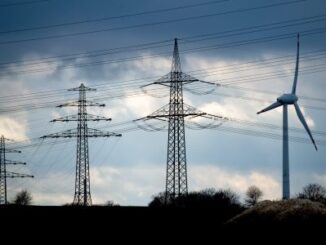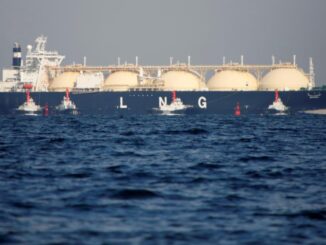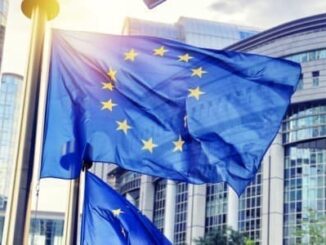![Green growth or green defeat? Europe’s Clean Industrial Deal in the balance [Advocacy Lab Content] Clean Industrial Deal](https://energynewsbeat.co/wp-content/uploads/2025/01/GettyImages-1441154416-450x300-A86jRS.jpeg)
As Europe navigates the complexities of its Clean Industrial Deal, a fine balance must be struck between rapid decarbonisation and preserving industrial competitiveness.
With climate commitments pressing forward, the EU faces the challenge of reinventing its green energy landscape while simultaneously competing on the global stage. Critical raw materials, technological innovation, and access to financing are at the core of this transition.
XZ: How can the Clean Industrial Deal balance the need for rapid decarbonisation with the imperative of maintaining industrial competitiveness on a global scale, while maintaining climate commitments?
PŚ: Europe’s Green Deal should have incorporated an industrial dimension from the very outset. The transition to net zero is a prolonged process, scheduled to take place over the next 25 years, with a lot of trade-offs along the way. As such, it should be accompanied, to the extent possible, by significant economic value creation.
Phrased differently, the green transition must involve an economic growth agenda.
From this perspective, the Clean Industrial Deal comes several years late, and Europe has seen an undue weakening of its market position in key sectors of the green transition, including solar and wind technology.
Global solar supply chains, where Europe still held a leading position until the early 2010s, are now utterly dominated by China, which produces 88% of the global supply of polysilicon (the main raw material for solar PV), 97% of the silicon wafers (the core component of solar cells), and 85% of the world’s solar cells.
In designing the Clean Industrial Deal, foresight should be the starting point. All existing net-zero scenarios, whether by the European Commission or companies such as EDF, envisage clean energy reaching a 75-100% share of the power mix by 2050.
This means the EU needs to double down on the technologies that will be of central importance, primarily wind, solar and nuclear.
The first two will together constitute two-thirds of the 1.8 times larger power production that will be needed in 2050 to meet the total demand, which exemplifies the high stakes involved in preserving Europe’s share of manufacturing in both sectors.
At the same time, Europe should build on its existing strengths, an approach which is at the heart of the Competitiveness Compass proposed by the European Commission.
The Compass should prioritise those sectors and their supply chains where Europe holds or can recover a competitive position, (…) economic security demands that external dependencies at the highest risk of weaponisation by foreign actors are urgently addressed.
Although it might not be the first instinct of European policymakers, the experience of East Asian “developmental environmentalism” and its sophisticated economic statecraft needs to be studied carefully.
Too often, an assumption is made in Europe that China’s recent success story in building industrial strength in the clean energy sector is a function of massive subsidies alone. In reality, the extensive ecosystem able to develop enormous capacity has been as important, as has ample access to finance for start-ups.
XZ: How does the Clean Industrial Deal plan to address the financing gap for decarbonisation, particularly for Member States with less access to public aid and higher reliance on high-emission industries, to ensure equitable support?
PŚ: Cleantech and the green transition must be a top priority spending for the EU, on par with defence. This means increasing contributions from both the public and private sectors to cover the current investment shortfall which stands at 2.6% of GDP.
The flagship REPowerEU and NextGenerationEU programmes have been highly impactful, but their future is far from assured and the Member States still need to agree on their much-needed extension.
Since electrification needs to be the main avenue of solving the energy trilemma, of sustainability, affordability and security, investments in clean power generation as well as grids and storage are of essence.
Given the 23% share of electricity in the total EU energy consumption, the transition is far from achieved.
Climate investments are critical for building lead markets for the European industry’s clean tech sector. A massive leveraging of private capital will be required for this purpose, with the European Investment Bank (EIB) and National Promotional Banks having to play a key role in risk reduction.
A powerful investment case will have to be built for all cleantech developments. InvestEU should expand towards counter-guarantees to provide financial backing that reduces the risk exposures for financial intermediaries.
Investment gaps are acute in wind power, with only 17% of annual investment needs currently being met. Similarly, electricity grids require an estimated €375-425 billion in investment by 2030.
In contrast, battery storage and hydropower exceeded annual investment needs in 2022, while solar panel investments reached 78% of the required level.
To structurally reduce costs and ensure a stable, affordable energy supply resilient to external shocks, active and cost-effective supply-side policies, combined with accelerated electrification, are essential.
Future investment scenarios must reflect the fact that the starting points and investment needs of individual countries differ extensively, implying widely differing costs of transition.
XZ: What measures will the Clean Industrial Deal implement to secure access to critical raw materials and technologies, prevent over-reliance on imports, and reduce dependencies on non-EU countries, while ensuring fair global trade practices?
PŚ: Rapidly growing deployment of clean technologies entails a sharp increase in Europe’s reliance on imports of critical raw materials and component parts.
Critical minerals are the lifeblood of the clean energy transition with the demand for lithium expected to triple, for copper more than double, for cobalt nearly quadruple and for nickel to increase more than five times by 2030.
China’s overwhelming dominance in clean energy supply chains and its growing use of strategic dependencies as instruments of economic coercion, coupled with Russia’s cyberattacks on EU energy infrastructure, must be a wake-up call for European policymakers.
A stable and secure supply of essential materials is necessary for the green and digital transition, an objective which is at the heart of the EU’s Critical Raw Materials (CRM) Act.
While building a vibrant recycling sector and pursuing active partnerships with third countries is essential, Europe needs to put in place a system for CRM stockpiling, involving not only the physical reserves of materials but also strategic coordination across Member States on how to manage them efficiently.
Such an approach can mitigate supply chain disruptions and market volatility, ensuring that industries reliant on these materials can continue to operate smoothly.
Clear guidelines will be needed for the amount and types of materials to be stockpiled, as well as mechanisms for their maintenance and rotation to prevent degradation.
Incentives for private producers to participate in stockpiling efforts will require regulatory measures that mandate storage requirements or financial incentives such as fixed-price contracting. The latter can guarantee producers a stable return on their investments.
XZ: Innovation is crucial for achieving energy and industrial transformation. How will the Clean Industrial Deal bridge the R&D disparities across the Member States to ensure cohesive technological progress within the EU?
PŚ: While the deployment of innovation is often the immediate priority, the development of new disruptive technology is essential to meet the net-zero transition objectives.
The International Energy Agency’s Net Zero by 2050 roadmap highlights that 35% of the emissions reductions needed to reach net zero will rely on technologies that are not yet commercially available or widely deployed today. They include clean hydrogen production and applications, advanced battery technologies, carbon capture, utilization, and storage, direct air capture or next-generation renewables.
This underscores the importance of robust investment in research, development, and innovation across the energy sector. In addition, breakthroughs create positive knowledge spillovers. This means that a level playing field needs to be maintained between incumbents and new entrants in the policy design.
Internationally, there is intensifying competition in the research and development phase of cleantech development.
According to an analysis by the German Patent and Trademark Office, Chinese entities filed 117 patent applications in solar technology in 2023, more than twice as many as in 2022.
While German patent registrations also increased by an impressive 11%, this was the first time that China published as many applications in solar technology as Germany.
Significant new funding for cleantech R&D is, therefore, essential from the point of view of preserving Europe’s competitive position in the full course of the net-zero transition, between now and 2050.
Disparities in R&D among Member States need to be proactively addressed by focusing on building research infrastructure in underperforming areas and supporting R&D in cleantech in regions transitioning from carbon-intensive industries.
European innovation partnerships and regional clusters should include countries with varying intensities of R&D spending. In addition, programmes to train and retrain researchers in countries with lower R&D levels are necessary for talent retention.
Given that procurement is often the most effective innovation policy, standardised criteria for clean tech procurement should be introduced. Early-stage technology developments should be actively shielded by trade policy measures.
XZ: How does the Clean Industrial Deal align with international trade policies and climate agreements, addressing potential conflicts with other global economies?
PŚ: Trade protection measures must be part and parcel of the Clean Industrial Deal, given the extent of distortions in the level-playing field internationally.
The EU will not shy away from introducing countervailing duties wherever needed, as shown by the recent measures against electric vehicle imports from China.
Its approach should remain evidence-based, as was the case in 2023 and 2024 when the European Commission carried out a thorough investigation, following concerns that Chinese EVs had benefited from unfair subsidies.
At the same time, there needs to be a clear link between the trade and the competitiveness agenda.
Europe’s inability to speak with one voice on trade issues, as shown by the fact that five Member States voted against the duties on Chinese EVs in the October 2024 Council vote and other countries, such as Spain, abstained [should not] mean that it pursues a disjointed approach with respect to third countries’ investment in Europe, and the nature of the relationship with foreign, in particular Chinese, technology companies.
As was reported in October 2024, China instructed its car and battery companies to withhold big investments in those European countries that vote in favour of imposing tariffs.
Conversely, funding seems to have been available elsewhere, as shown by the plans to build a battery gigafactory in Spain, announced in December by Stellantis and the Chinese CATL.
Seeking workable international solutions regarding permissible environmental subsidy practices remains of the essence as well. Otherwise, trade tensions may easily create a downward spiral of trade protectionism, which will not be in the interest of the net-zero transition.
This effort needs to start with greater transparency of public funding and the necessary data collection and analysis. New proposals are then needed on best practices and the reform of the rules on permissible environmental subsidies.
The latter could take the form of an expanded carve-out for the decarbonisation of existing production capacities in the Agreement on Subsidies and Countervailing Measures.
This would allow for subsidies designed to reduce carbon emissions, provided they are structured to avoid protectionist effects.
XZ: What lessons can the EU draw from cleantech projects, such as the recent case with Northvolt, in terms of state interventionism and Europe’s vulnerabilities in cleantech?
PŚ: The EU has done a lot to support its EV battery sector, but in the end failed to grapple with the need for scale and speed in policy.
In 2017, it launched the Battery Alliance to “make Europe a global leader in sustainable battery production in use” and gather all the relevant EU industrial and research stakeholders.
The Battery Regulation, which went into force in 2023, aimed at both the sustainability of production and recycling of batteries, and the level playing field. In February 2022, the European Battery Alliance Academy was launched to train, skill, and upskill approximately 800,000 workers by 2025 and ensure talent retention.
The reality of battery production, however, has proven to be highly complex. European start-ups and producers have struggled with high costs and challenges on the demand side.
Although more than 1.5 million battery electric cars were registered in EU countries in 2023, compared to more than 1.1 million in 2022, as shown by the European Environment Agency, this dynamic remains below expectations.
Tough competition from China, where the EV sector has grown consistently since the early 2010s, has contributed to a sense of continued headwinds.
Northvolt, the struggling Swedish battery producer that filed for Chapter 11 protection in November 2024, has been the emblematic company in the European effort to build a homegrown battery value chain.
It received substantial public and private support, including a 5-billion-euro loan from the European Investment Bank and Volkswagen, which took a 21% stake in the company in 2019.
However, when Northvolt delivered less than 1% of its 16 GWh capacity in 2023, turning the corner became a mission impossible. Various failures account for this, including with respect to corporate management, and significant reliance on imports of Chinese material and machinery.
They testify to the fact that betting the future of a sector on one darling company is never a good idea. Gladly, the EU has several promising actors in the battery ecosystem, including Verkor, or ACC, all of whom need to benefit from support in an equidistant fashion.
One important lesson from the experience of the battery sector is the need for a fully-fledged life-cycle support that goes all the way from R&D, through product development, to ramping up production. The EU offers various support schemes for these stages but often in a fragmented fashion.
In addition, the scale of the support tends to be suboptimal and significantly inferior to what Chinese competitors can count upon.
Lastly, the focus on supply chains should have become much more central earlier on, reducing dependence on imported raw materials such as lithium and cobalt.
[Edited By Brian Maguire | Euractiv’s Advocacy Lab ]
We give you energy news and help invest in energy projects too, click here to learn more





